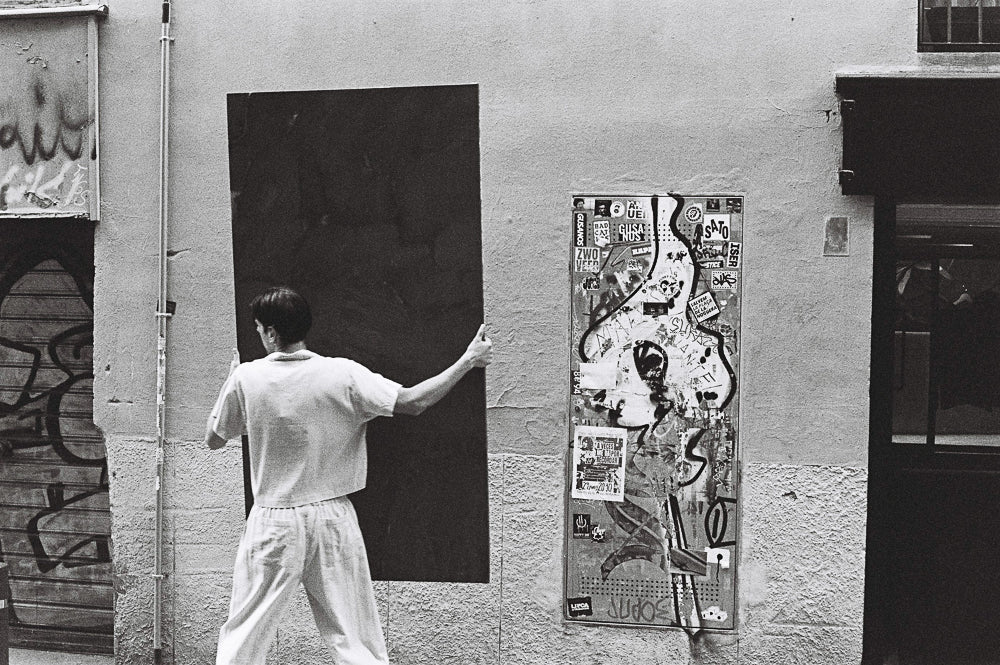One afternoon this July, we had the pleasure of welcoming Fernando Loyola, an Argentinian-born, Barcelona-based artist, to our studio to chat about his work. With his stylish appearance and soft-spoken, thoughtful demeanour, Fernando was a captivating guest. We could have easily spent much more time delving into his insights if not for the demands of work and the art that awaited creation. Below is an excerpt from our short conversation right before his show at our space "Con mi sombra somos tres". (The accompanying images where shot during the set up of the show)

When did you make the move from Buenos Aires to Barcelona and what are the main differences between the two cities for you as an artist?
I have been living and working in Barcelona since 2014. Buenos Aires is a much bigger city, the art scene is very different. Latin America has nothing to do with Europe. Living in a crisis keeps you alert. Barcelona, on the other hand, provides me with a calmer and more reflective environment, allowing me to focus on my work.


You studied graphic design in Buenos Aires. Can you tell us what you dislike and like about it, and, if at all, how a graphic design background influences the way you make art?
What I liked most about my university studies was being in contact with such diverse people from so many different places. I was suffocating growing up in a small town. Finding myself in a totally new environment gave me a lot of hope. Today, reflecting on my studies, I regret not having studied art but as a designer I got a job quickly and was able to move forward with my life.
When did you know you wanted to be an artist? Was there a specific moment or had it always been something you considered?
I decided to dedicate myself to art because I could no longer pretend otherwise. I gradually shed everything unnecessary in my life, and what remained was art. I've been painting since I was a child, but I needed some time to get to know myself, explore, and make the decision that I always knew I had to make.

Who or what inspires you as an artist?
I draw inspiration from Abstract Expressionism. This movement resonates with me because of its emphasis on spontaneity, emotion, and the physical act of painting. The way artists in this genre explore their inner feelings and translate them onto the canvas inspires me to delve deeper into my own emotional landscape and express it through my work. My art stems from a disillusionment with the collective. Creating art makes me feel free; to do so, I need to be in solitude and follow my processes. I retreat into my inner self and try to abandon all external references.

Your works are often quite big. Why is this and would you ever consider making smaller pieces?
I define my works as "paintings that represent emotional situations," through which I aim to recreate the intensity of experience. The size helps to immerse viewers, making them feel the energy behind the work more viscerally.

You often make use of bright colours but then sometimes have a more subdued palette when working with acrylic as can be seen in your work ‘Olvidable’ for example, could you tell us some more about the reasoning or intention with this?
My paintings evoke an underworld, suggesting elements that refer to nature and what occurs deep within. Earthy tones and reds seem to represent the interior of the earth, connecting with the genesis of what happens beneath the surface. Indefinite shapes float in unfounded environments. I create elusive spaces and dreamlike realms where fictional narratives unfold. These resemble abstract surrealist landscapes. The figures are connected naturally, intertwined, pushing against each other, wrapped in dirty colors and broken textures that allow the background color to subtly emerge.

Your work is often abstract. Could you tell us more about your process as an artist? Is it very instinctive or would you say there’s a lot of thought that goes into it? A bit of both perhaps?
I move away from figuration and seek a composition that focuses on the use of color. I start from a background and play with hiding and revealing through the layering of paint. I always know where I want to start to dirty the canvas, and then it takes shape. Generally, I am not satisfied because abstract art is a search. Sometimes it happens, and many other times it doesn’t. There’s something about wanting to go to a place and not arriving.

What advice would you give to younger people wanting to be artists?
I would advise them to stay true to their vision and not be afraid to experiment and make mistakes. Authenticity and perseverance are key to developing your own style. Additionally, it is important to be open to learning from others and finding inspiration from various sources.
What are you working on at the moment? Do you have any upcoming exhibitions you can tell us about?
I’m always painting. I like to be ready for what’s coming. For the past few months I’ve been researching and testing materials for a series of sculptures. I’m also excited to explore performance art soon. As for upcoming shows, I’m working on my first solo exhibition, which will take place in January next year at Beta Contemporary in Barcelona. In March, I’ll be in Madrid at an art fair called Urvanity also with Beta.



